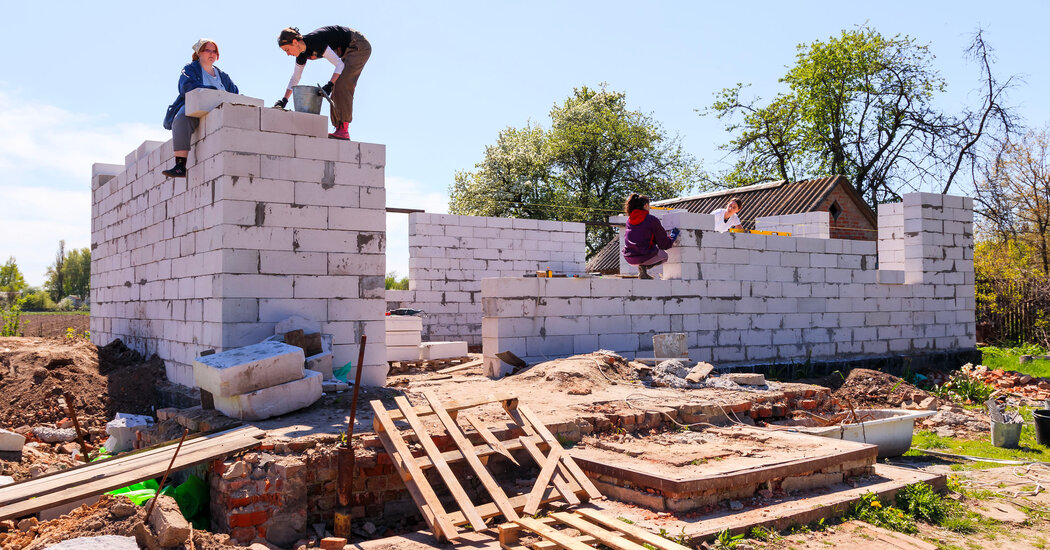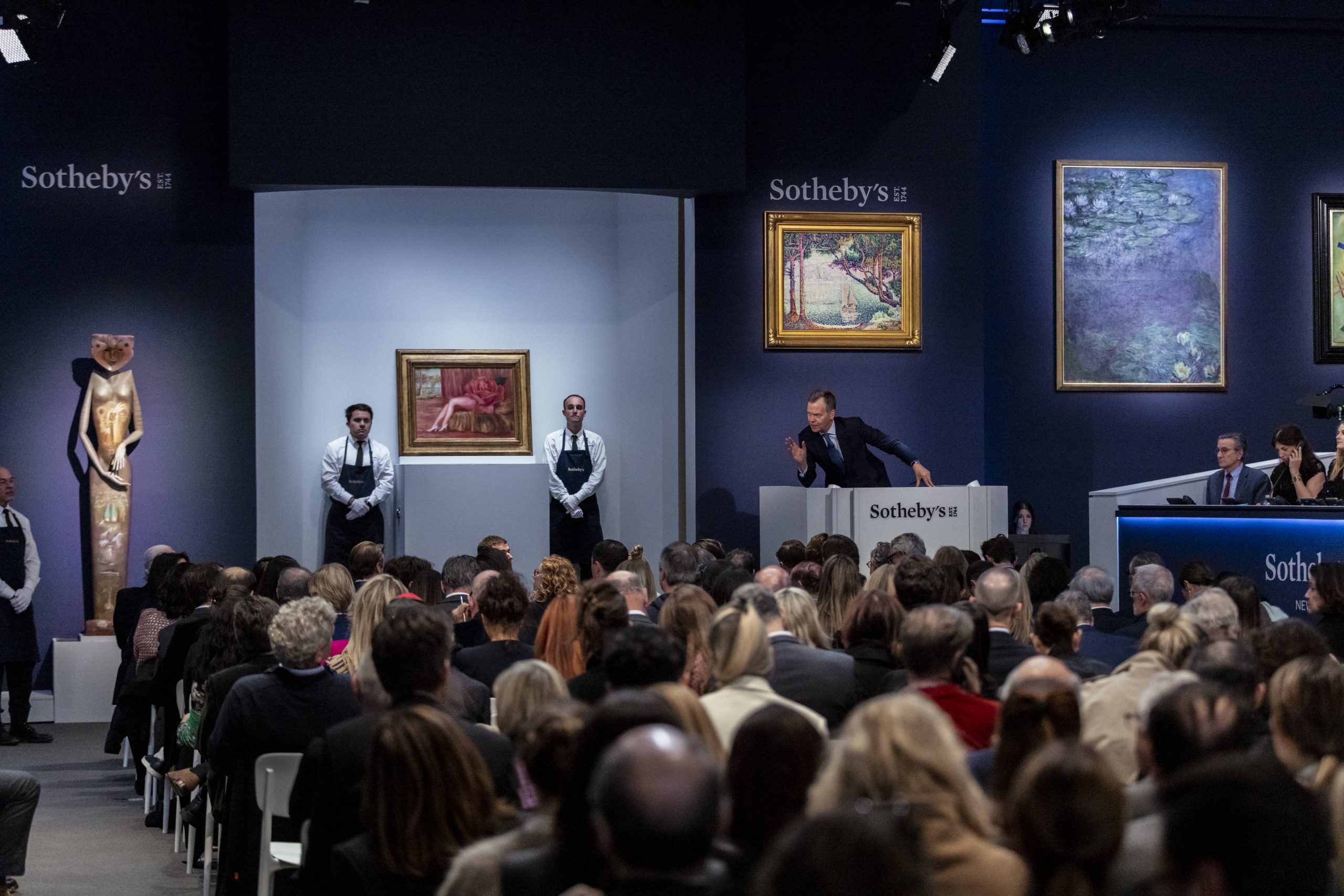When the German Army finally broke through in central Ukraine in September 1941, pasting up ordinances around Kyiv to announce a new occupying authority, they had only a few days’ calm. Less than a week after the occupation began, bombs started exploding right in the city center. The Soviets were dynamiting Kyiv, reducing their own city to ungovernable rubble, in a ferocious counteraction that would be commemorated very differently in Russia and in Ukraine.
Walk through central Kyiv today, down the Khreshchatyk, past the grand Independence Square and the ritzy Tsum department store, and you can read the history of postwar and post-independence Ukraine in the subsequent architecture.
The marble of the Stalinist skyscrapers, the concrete of the cheap Khrushchevka housing blocks, the glass and chrome of the oligarchs’ new towers: Within each of these materials is a record of destruction and reconstruction, of past wars and, now, a present one. In the third year of this epochal war — which has destroyed some 210,000 buildings, according to a recent New York Times investigation — Russian forces continue to target civilian habitations in contravention of international law. When the city is a battleground, architecture becomes an act of defense and defiance.
There’s a high-spirited, highly welcome exhibition right now in New York that maps Russia’s attacks against Ukraine as also a war against the built environment, and the manners in which architects, designers and ad hoc collectives are fighting back in brick and mortar. “Constructing Hope: Ukraine,” on view at the Center for Architecture in downtown Manhattan, brings together models, maquettes, and videos documenting more than a dozen grass-roots initiatives in contemporary Ukrainian housing and infrastructure. There’s snap-together furniture for displaced person camps in the west, student-designed playgrounds that can be quickly constructed in the east — and, throughout, a double focus on design as an emergency measure and a long-term national project.
The Ukrainian government and army have already begun major rebuilding projects. Bucha and Irpin, the devastated Kyiv suburbs, have become significant construction sites. The architect Norman Foster has been engaged for a new master plan for Kharkiv, whose extraordinary density of modern architecture faces near daily bombardment. But this exhibition keeps its focus on informal and bottom-up efforts in Ukrainian architecture. It showcases the work of architects inside and outside the country, but also some of Ukraine’s most important artists — not to mention the ravers and DJs of Kyiv’s world-leading electronic music scene, who have been aiding reconstruction efforts while the records spin.
Vladimir V. Putin began a full-scale war against Ukraine in February 2022, but Russia has in fact been at war with the country since 2014, when it responded to Ukraine’s democratic, pro-European Maidan Revolution by occupying Crimea and invading the country’s easternmost regions. That lower-intensity war meant that Ukrainian architects and urbanists had experience with displacement and destruction when, two years ago, millions of citizens began fleeing from east to west.
In Lviv, the Ukrainian firm Drozdov & Partners and volunteer students from the Kharkiv School of Architecture quickly erected cardboard partitioning units for hundreds of dispossessed people, adapting and redeploying a system first developed by the Japanese architect Shigeru Ban. An NGO, MetaLab, designed a cohousing project for those who had lost homes in the war. Called Co-Haty, a play on the Ukrainian words for “love” and “houses,” it includes a modular, quick-to-assemble wooden bed of the same name that you can now find in empty government buildings and pop-up shelters.
In Lviv and the other cities of western Ukraine, your house is relatively safe. In Kyiv and in cities to the east, it has to double as an emergency shelter. Every Ukrainian now knows the rule of two walls: When the air alert sounds, and if you can’t get somewhere safer, you want to move to the interior of your apartment, so that if an outside wall gets hit by a projectile the inner one can stop the shards. (The bathroom is usually your best bet.) You tape up the windows — as the graphic designer Aliona Solomadina has evoked on the Center for Architecture’s view onto LaGuardia Place — but that may not be enough. The blast wave from an exploding shell can shatter windows more than 1,000 feet away, and thanks to Russia’s pitiless attacks on Ukraine’s electrical infrastructure the winter can come right inside.
Windows are the most vulnerable component of architecture, as well as one of the most expensive. Before the full-scale invasion, Ukrainians got theirs from now-shuttered factories in the Donbas or from Russian exporters. Today, thousands of used or repurposed PVC windows are being funneled from Warsaw to Kyiv and then to the most endangered regions, a project of the Polish-based BRDA foundation that has enabled numerous internally displaced Ukrainians to rebuild and go home. As this show recounts, before the 2014 Maidan revolution collective architecture in Ukraine had a bad rap — it sounded Soviet, and had no place in the turbo-capitalist Ukraine of the 1990s and 2000s. Today, amid existential threats to both the social and architectural fabric, the common good is back.
You have a roof over your head, you have mastered the art of sleeping in the bathtub during the raids, but there will always be other houses in your dreams: your dreams and, also, your nightmares. In 2022 the artist collective Prykarpattian Theater brought together more than a dozen displaced Ukrainians and asked them to cast their memories back to the homes they had been forced to abandon. Porches, gables, a simple concrete garage: These were the building blocks of an independent Ukraine they had left behind. Together, the artists and refugees produced small, tender, fragile models of these bygone houses, which fill the central gallery of the Center for Architecture now — one of so many new Ukrainian artistic endeavors that have reimagined culture as a practice of archiving against oblivion.
“We speak of the cities we lived in — / that went / into night like ships into the winter sea…”, begins a poem by the Ukrainian author Serhiy Zhadan. Kyiv and Kharkiv, Odesa and Dnipro, have sailed into this century’s black waters ahead of us, and one of the values of this exhibition is how it demonstrates that the war in Ukraine — an imperial war, a culture war — is not taking place “over there,” at some safe distance from our freedoms and our bank accounts. The war long ago spilled beyond Ukraine’s borders, into Europe’s economies and America’s political campaigns. It will not end soon, and will reshape our own cities before it does.
Constructing Hope: Ukraine
Through Sept. 3 at the Center for Architecture, 536 LaGuardia Place, Manhattan; 212-683-0023, centerforarchitecture.org.










